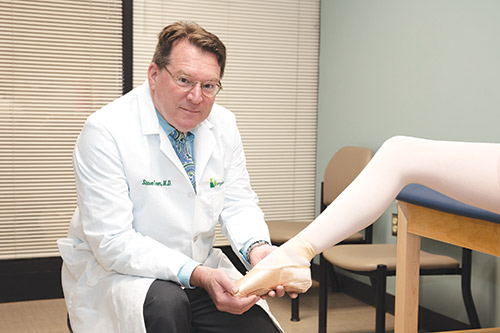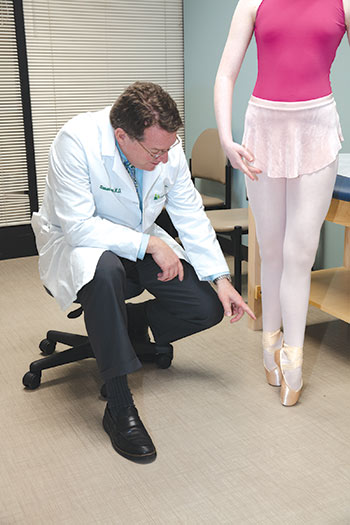Step Up To The Stage
Performing artists can benefit from musculoskeletal medicine
A ballet dancer who is performing well might see herself as graceful as a swan or as fluid as flowing water. But with the crucial attributes of physical strength, agility and balance, she’s really closer to being an NFL wide receiver.
That’s why dancers and other performing artists can benefit from seeing doctors like Steven Greer, MD, at St. Joseph’s/Candler Physician Network – Bone, Joint & Muscle Care.

“Artists don’t always see the point in seeing someone who, in their mind, is a sports doctor,” says Dr. Greer. “But we are here to help you keep doing what you love. Just as we do with athletes or any other kind of patient, we figure out how to care for your injury or overuse issue so that you can get back to your life.”
No Understudy
While the risk of physical injury may not be as obvious in performing arts as it is in football, it is still a valid one. Dancers may experience ankle sprains, knee and hip injuries or back pain. Musicians may struggle with tendonitis or carpal tunnel syndrome. To make matters more precarious, sometimes these artists might not be able to take an extended break from their art.
Dr. Greer recalls adjusting the movements and practice schedule for a ballet dancer who was the male principal in The Nutcracker.
“He was the male principal for multiple small towns in rural Georgia, performing with all the ballet schools in these different places,” Dr. Greer says. “These children had been practicing all year for the chance to do The Nutcracker, and they couldn’t do it without him. So we had to help him find a way to do it. It’s not like a ballet company in New York City—there was no understudy.”
Another one of Dr. Greer’s patients was a flautist who developed carpal tunnel syndrome. At the time, she was paying for her music education by playing with a professional group on the side. She couldn’t afford to quit performing.

“We had to change her practice technique while she recovered,” Dr. Greer recalls. “That meant fewer trills and 16th notes and 32nd notes. We worked with her to adjust her practice schedule so that she could rest her hand whenever it was feasible.”
On Point
Ballet, in particular, is known as both a physically and mentally demanding art form that requires strong discipline and perseverance, often alongside fierce competitors for roles. This can sometimes create a culture in which pain is “worked through” in order to meet the pressures of performance.
Dr. Greer encourages performers and their instructors to see the benefit in learning from providers who can share their musculoskeletal knowledge and expertise. And, most importantly, to not be afraid to acknowledge an injury and give themselves a chance to heal.
“A ballerina might come to my office with an injury and be terrified that I am just going to tell her she can’t dance,” Dr. Greer says. “Instead, I ask questions. ‘Does performing a relevé hurt more than being on demi-pointe?’ They look at me completely differently. They know that I understand what they do and they are more open to the different ways I can help them.”
St. Joseph’s/Candler Physician Network – Bone, Joint & Muscle Care is located in Suite 330 at the SJ/C Pooler Campus. The office sees patients every weekday except Wednesday. The Savannah office of SJ/C Physician Network – Bone, Joint & Muscle Care sees patients on Wednesdays only, and is located in Suite 102 of the Professional Building on the Candler Hospital campus.
Services offered include diagnosing and treating musculoskeletal conditions, athletic injuries and non-surgical fracture care. Dr. Greer also can help with injury prevention, strengthening and joint flexibility management.
To learn more or to make an appointment, call 912-737-2450.